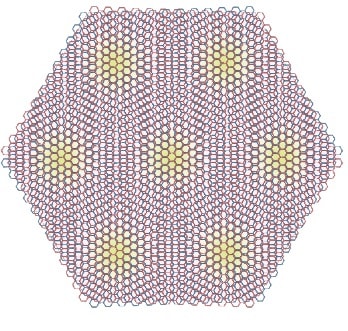Pristine graphene produces giant photoresponse
19 Dec 2018 Belle Dumé
Graphene is a sheet of carbon just one atom thick and has many unique properties, such as extraordinarily high electron mobility and high thermal conductivity. It can also, in principle, absorb light over all frequencies of the electromagnetic spectrum, which makes it ideal for use in photodetectors, biosensing and bioimaging applications, as well as in night vision devices. Now a team of researchers at the University of California at Riverside and the Massachusetts Institute of Technology (MIT) has discovered that pristine graphene can produce large amounts of photocurrent when illuminated with light if it is made into special, constricted, shapes. The unexpected thing about this photocurrent is that it occurs at graphene’s charge neutrality point – at which current flow is not expected at all. The new finding could be important for developing more efficient and ultrafast photodetectors and even improved light-harvesting devices like solar panels.
In 2011, a team of researchers led by Pablo Jarillo-Herrero discovered that, when exposed to light, graphene produces “hot electrons” that then generate a photocurrent. This so-called hot-carrier regime is very unusual and is normally only seen at extremely low temperatures or in very non-linear processes, but in graphene it occurs at all temperatures from very low up to room temperature – and in the linear regime – when the material is excited with a laser.
Graphene can also produce a photocurrent when it is subjected to electric fields. Despite the fact that the processes responsible for producing these two types of photocurrent (thermoelectric and photovoltaic) are very different, they do share a common feature in that they are prominent at high charge densities but suppressed at the charge neutrality point. This is the point at which the valence and conduction bands meet and is also called the Dirac point. This behaviour is in complete contrast to what the researchers have now observed in pristine graphene – that is, graphene free of excess electronic charges such as those induced by doping or defects.
Unusual configurations
The team observed the Dirac-point photocurrent in samples cut and shaped into unusual configurations, like ladder-like linear arrays, narrowly constructed rectangles and samples with tapered and tailored edges. The largest photocurrent emerges in constricted areas, such as in the regions where a narrow ribbon connects wide regions, when they are illuminated with light.
Jarillo-Herrero and colleagues obtained their results by exciting their samples with a focused 850-nm continuous-wave laser and measuring this photocurrent through source and drain electrode contacts.
“Until now, converting light into electricity in graphene relied on the photothermoelectric effect,” explains Jarillo-Herrero. “For this effect to work, we need a junction formed between electron- and hole-doped graphene. This is the same as what we need in most other solar energy harvesting or photodetection devices. Here, the electrical current is generated in the junction region and moves through the distinct areas between the differently doped parts.
“What is different in graphene, however, is that the Fermi level shifts off the Dirac point and into the conduction or valence band once the material is doped with charge carriers. And this unfortunately blocks the material’s ability to absorb low-frequency photons.”
“In our new work, we show that pristine graphene can convert light into electricity very well without the need for doping and without the need for a p-n junction structure. This means it continues to absorb light at any low frequency.”No special junctions required
“When we shine a laser on a perfectly neutral device, electrons are pushed away from the light beam, driving a local current, adds team member Nathaniel Gabor. “When you shine the laser on a corner or constriction, however, the electrons are forced to travel in only certain directions (they have to be along the same momentum line). And since the electrons travel long distances at the Dirac point in graphene, they eventually produce a strong photocurrent.”READ MORE

Strongly interacting electrons
The phenomenon comes from the fact that electrons in pristine graphene interact very strongly with each other since they are confined to a very thin, atom-sized membrane, he adds. They are thus expected to behave as a liquid, transferring their energy collectively as they move.
“Combining the hot electrons that exist in graphene with the fact that we don’t require any sort of junction in it, means that we can engineer and control the behaviour of light-harvesting devices made of this material by simply exploiting the shape and size of a sample. What is more, because the sample is only one atom thick, we could use it to make devices that are semi-transparent and shaped to generate large populations of hot electrons. These could be embedded in structures such as windows panes, for example, or combined with other more conventional photosensitive materials to harvest excess energy from sunlight that is not usually absorbed.
The researchers, who detail their work in Nature Nanotechnology 10.1038/s41565-018-0323-8, say that they now plan to further study graphene’s intrinsic photocurrent effect over a broad range of infrared and THz frequencies and measure its response speed. “Our current work was carried out on mechanically exfoliated samples of the carbon sheet and we now hope to use material grown by chemical vapour deposition (CVD) as the next step for scale up,” says Jarillo-Herrero.

21/12/2018 FROM PHYSICSWORLD.COM

Δεν υπάρχουν σχόλια:
Δημοσίευση σχολίου